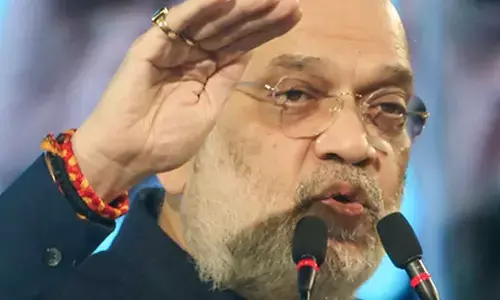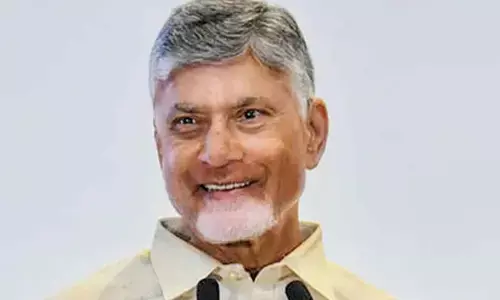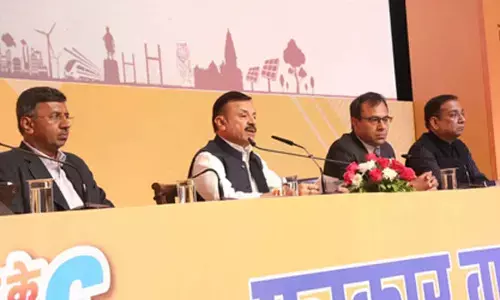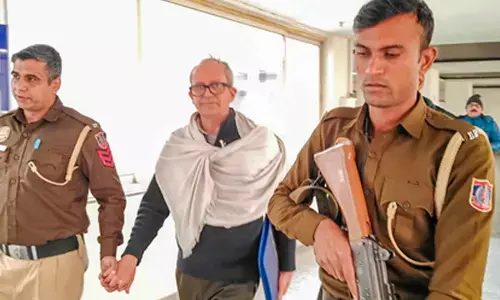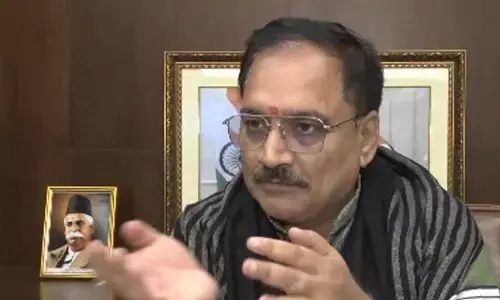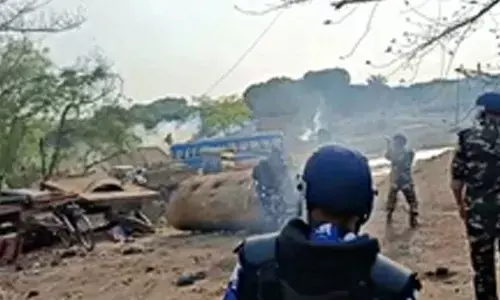Exploring the other side
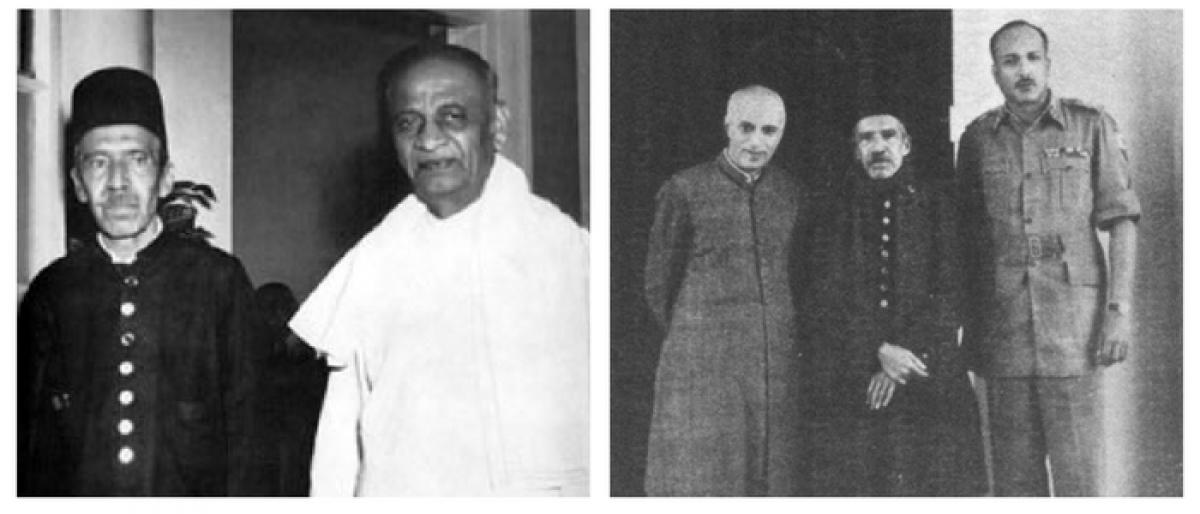
This, in essence, is the point that the author of the book ‘Hyderabad 1948: An Avoidable Invasion’, Syed Ali Hashmi tries to prove. Without indulging in mudslinging, keeping his tone sober and the narrative simple. He makes a vigorous attempt to bring into focus, nefarious designs of powers that be, to annex by hook or crook, a flourishing and advanced Princely State into the Union of India.
The book ‘Hyderabad 1948: An Avoidable Invasion’, as the name suggests, explores the other face of invasion on Princely State of Hyderabad by Union of Indi
This, in essence, is the point that the author of the book ‘Hyderabad 1948: An Avoidable Invasion’, Syed Ali Hashmi tries to prove. Without indulging in mudslinging, keeping his tone sober and the narrative simple. He makes a vigorous attempt to bring into focus, nefarious designs of powers that be, to annex by hook or crook, a flourishing and advanced Princely State into the Union of India.
If India's claim on Hyderabad was a valid one, there would not have been any need for her to sign a Standstill Agreement with Hyderabad on November 29, 1947 - that too with an arbitration clause! Arbitration is agreed to between two parties as equals the author reminds his readers.
Zealously lending support to the treacherous plan of Sardar Patel was KM Munshi, whose reputation as a hardcore communalist had preceded his arrival in Hyderabad as Agent General of India. Not just the two, the entire Congress party was on the same page when it came to the issue of annexation of Hyderabad.
Possible exceptions could be Gandhiji and C Rajagopalachari, Governor General after Mountbatten demitted office. Pandit Nehru snapped his fingers and blurted out: “I shall reduce Hyderabad to smithereens." so says the author quoting Laiq Ali.
Maulana Azad took his hands off the Hyderabad matter on the slightest pretext by calling Laiq Ali a "bhagoda" (Renegade) - for his folly of not showing up for the next meeting. Achyut Patwardhan, at one time a CWC member, had actually resigned from Congress to lead a socialist group, which wreaked havoc on not just the Hyderabad citizenry, also on the government servants, who opposed his "Parallel Government" formed in Satara. It was called ‘Poona Patri Sarkar’.
Adding strength and vigour to the malicious intent of the Congress big wigs were leaders of the Hyderabad State Congress. About whom, in an internal report to Gandhiji, Padmaja Naidu, daughter of Sarojini Naidu, had written; 'original founders of the Hyderabad State Congress almost all hailed from communal organisations'. Quite in contrast to this, VK Bawa, IAS (retd) of AP Cadre, admitted that 'the Majlis was established as a reaction to the Arya Samaj'.
Relying on published material, the author has tried to establish that despite all the pretensions to the contrary by the Congress, its intent from the start was to integrate Hyderabad into the Indian union. Subterfuge, coercion, military action, it would resort to anything to achieve the object of "removing the 'Ulcer' from the abdomen" as Patel called it.
But the author does not hold back his punches for the traitors from within. Full throatily he goes on to lambast the arch-villain Major General Ahmed El Edroos, Cin C of the Hyderabad Army.
Husband to a Jewish wife, his loyalty was always suspect but not really understood till the Indian Army actually got a cake walk in Hyderabad.
Not to be left behind were a host of Hyderabadi nobles holding important positions in the Nizam's Government. Zain Yaar Jung, Deen Yaar Jung, Ali Yavar Jung, Hosh Yaar Jung, Zulqadar Jung are to name a few from the titled nobility who were playing on both sides of the court.
But what comes out as utterly disgraceful is that none less than the Crown prince, HH The Prince of Berar and his younger brother Prince Moazzam Jah were also overtly and covertly trying to curry favour with the new government in Delhi. The former was keen to formalise the surrender by presenting the sword in person. The latter had actually written a letter to Union Government stating that 'his father was leading Hyderabad to destruction'.
Laiq Ali and Qasim Razvi president of the Political party Majlis-e-Ittehad-ul Muslimeen, parent body to the much maligned Razakaars (Volunteers) have been dealt with in a matter of fact like manner. Without appearing to be holding a brief for any of the three mentioned, the author has brought out facts in an objective manner.
Laiq Ali, a successful business man actually took up the premiership of Hyderabad most reluctantly and only as a call for duty. He shouldered his responsibility in a statesman like manner. Displayed a commendable knack of negotiations, a tremendous sense of fair play and understanding of issues. But alas!
All his untiring efforts and well-meaning endeavours for a peaceful settlement came to a nought. To top it up, he had to take the entire blame of running into a confrontation with the Union Government. This way the Nizam managed to save for himself whatever wealth and position he could.
Definitely, but not consciously, the author seems to have done yeoman's service to Qasim Razvi and by extension to the Razakaars.
The highly biased Indian Press had gone to the extent of reporting that 'Razvi did not dine till he destroyed a few Hindus'. The author counters this allegation by reminding the readers that there were Hindus also among the Razakaars. A part of Qasim Razvi's speech delivered to his men going to war on September 13, 1948, should suffice as an indicator of his mind.
"And mind you! do not touch a non-Muslim of your country as we are at War with the Union of India and not with Hindus... He proved to be a much better leader of men by sending his son to the war front from which, as he said in his speech: "It is possible you may never return, get martyred and die in the way of God". He displayed exemplary moral courage by saying "I take full responsibility for what happened and only I should be punished for all the wrongs.”
In sharp contrast to this dignified -in - defeat behaviour of Razvi, Sardar Patel comes out as a man of no substance. From within the airplane, upon seeing the Nizam, who had come to receive him, he had remarked: ‘His Exhausted Highness' has come.
This lack of gracefulness in victory is highlighted in AG Noorani's book; ‘Destruction of Hyderabad’. And it definitely does not sit well on the shoulders of a person, who must have taken pride in Porus' retort to Alexander: “Treat me like a king treats a king”.
Nizam himself sets a sterling example by alighting from his car upon which a bomb is hurled and saving the culprit from getting lynched and ordering for his trial to be conducted in regular court. It is a different story that the man, Narayan Rao Pawar was later given awards and was labelled as “Bhagat Singh of Hyderabad”.
For all the bad mouthing and bad press Razvi got, he was imprisoned for eight long years but could not be convicted of homicide. Proof enough that he was more maligned than he deserved.
The author has touched upon the various organisations and their admitted role in causing mayhem in border areas of the Hyderabad State. Digamber Rao, Phoolchand Gandhi, Anant Bhane Rao, Ramchender Rao, Achyut Patwardhan, Swami Ramanand Teerath, some of whom later on became ministers in the first Congress government of the Hyderabad State, are amply quoted in the book declaring their heroics related with killings, destruction, plunder and loot.
Quoted figures related to all kinds of criminal activities makes one wonder as to how, in the face of such large scale destructive activity, organisations such as ‘The Action Committee’, ‘Poona Patri Sarkar’, ‘Socialist Group’, never came to be called terrorist organisations. These organisations raised a 'Voluntary Force' - running into thousands, whose objective was, and which got trained for causing mayhem, was conveniently ignored for being branded as terrorists or 'Razakaars' in the largely understood sense of the word.
Though Justice Katju only of late called the media 'Prostitutes', it's role as such, including All India Radio, has been brought under focus by the author. A story about an alleged instigative speech by Qasim Razvi during a 'Weapons Week' was played to the hilt to build a case for military intervention in Hyderabad.
It was confirmed to be utterly false by even members of the foreign media. But the canard spread about the Nizam having acquired a few Atom Bombs for use against India is the one which takes the cake - surely a fore runner to the " weapons of mass destruction ploy " used for toppling the Saddam Hussein regime a few decades later.
The Indian 'untruth' spin doctors can also be applauded for coining the phrase 'Police action' for a purely military initiative. The phrase was used by the Americans for their Military adventure against Korea.
The author, not in keeping with the normally practised principles of book writing, has drawn parallels aplenty from recent times. But then, it all seems to be with the genuine purpose of wanting history to be understood in proper perspective. A most stringent 'Economic blockade' was enforced ensuring that nothing, even common salt, medicines, and water purifying chlorine were not allowed to get into Hyderabad State. False propaganda, nightly raids to cause loss of infrastructure, life, limb, and property were methods used to level the ground for a military action in a totally landlocked and practically unarmed Princely State.
This could have been easily avoided and much misery heaped on especially Hyderabad's Muslim populace could have been averted. But the powers that be with a highly communal mindset on the issue would have nothing of the sort is the point the author has strived to drive home. His approach may be unconventional but is in keeping with the quote of Winston Churchill in his preface: "Those who forget History are doomed to repeat it...It is not wrong to lay lessons of the past before the future".
Incidentally, Churchill had in July 1948, itself equated Nehru's language on Hyderabad with that of Hitler before the invasion of Austria and Czechoslovakia.
Insignificant mistakes such as Asif Jah, first Nizam being called a Moghal (he was of Arab stock), or Bahadur Yaar Jung dying a year before Police Action in 1948 (he died in 1947) can easily be over looked. So, can the typo errors such as 'ague' for Hague and 'Ravi' for Razvi.
All in all, the book is a MUST read for especially the history buffs. All the more because of how it is being deliberately distorted in these days of growing greed for power, disharmony and intolerance.
By: Syed Inam ur Rahman. Ghayur.










